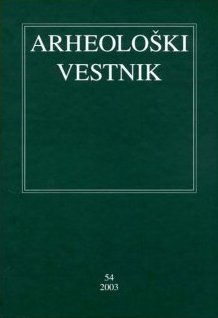Palaeolithic flutes: Divje babe I, Istállóskő, Lokve etc. Viewpoints of experts and their adversaries
Critical survey of the “Archaeological appraisal of the Divje babe I specimen No652”,and arguments to defend the specimens PB51/20 and Pb606 of the HNM Budapest
Abstract
The presumed or probably palaeolithic “flutes” of Divjebabe I and Istállóskő caves, with other “possible flutes” arediscussed on an objective basis. Refutation of the absolutelysure affirmations of the opposing party. Errors and tendentioustables are pointed out. There are only probabilities and subjectiveconvictions in this field and archaeology must cohabit withdreams
Downloads
References
ABSOLON, C. 1936, Les f lûtes paléolithiques de l’Aurignicienet du Magdalénien de Moravie (Analyse musicale etethnologique comparative, avec démonstrations). - Dans: Congrès Préhistorique de France Session XII, 770-784.
ALBRECHT, G., C.-S. HOLDERMANN, T. KERIG, J. LECHTERBECK et J. SERANGELI 1998, “Flöten” ausBärenknochen - die frühesten Musikinstrumente? - Arch. Korrbl. 28/1, 1-19.
ALBRECHT, G., C.-S. HOLDERMANN et J. SERANGELI2001, Towards an archaeological appraisal of specimen N°652 from Middle-Palaeolitihic level D / (layer 8) of the Divjebabe I. - Arh. vest. 52, 11-15.
BRADE, C. 1975, Die mittelalterlichen Kernspaltflöten Mittel-und Nordeuropas. Ein Beitrag zur Überlieferung prähistorischerund zur Typologie mittelalterlicher Kernspaltflöten. - GöttingerSchriften zur Vor-und Fühgeschichte 14.
BRODAR, M.1985, Fossile Knochendurchlochungen. - Razpr. 4. razr. SAZU 26, 29-47.
BRODAR, M. 1999, Die Kultur aus der Höhle Divje babe I. -Arh. vest. 50, 9-57.
BRODAR, S. et M. BRODAR 1983, Potočka zijalka. Visokogorskapostaja aurignacienskih lovcev (Potočka zijalka. Eine hochalpineAurignacjägerstation). - Dela 1. razr. SAZU 24/13.
CHASE, Ph. G.1990, Siff lets du Paléolithique moyen (?). Lesimplications d’un coprolithe de coyote actuel (1). - Bull. Soc. Préhist. Franç. 87/6, 165-167.
CHASE, P. G. et A. NOWELL 1998, Taphonomy of a suggestedMiddle Paleolithic bone flute from Slovenia. - CurrentAnthropology 39, 549-553.
DOBOSI, T. Viola 1985, Jewelry, Musical Instruments and ExoticObjects from Hungarian Paleolithic. - Folia Archaeologica 36, 7-38.
D’ERRICO, F., P. VILLA, A. C. PINTO LLONA et R. RUIZIDARRAGA 1998, A Middle Palaeolithic origin of music? Using cave-bear bone accumulations to assess the Divje BabeI bone ‘flute’. - Antiquity 72 (275), 65-79.
EINWÖGERER, T. et B. KÄFER 1998, Eine jungpaläolithischeKnochenflöte aus der Station bei Grubgraben bei Kammern, Niederösterreich. - Arch. Korrbl. 28/1, 21-30.
HAHN, J. et S. MÜNZEL 1995, Knochenf löten aus demAurignacien des Geißenklösterle bei Blaubeuren, Alb-Donau-Kreis. - Fundberichte aus Baden-Württemberg 20, 1-12.
HÄUSLER, A. 1960, Neue Funde steinzeitlicherMusikinstrumente in Osteuropa. - Wiss. Z. Univ. Halle Ges.- Sprachw. 9/3, 321-327.
HEIERLI, J. 1907, Das Kesslerloch bei Thaingen. - Neue Denkschriftender Schweizer. Naturf. Ges. 43, 176-177, T. 19: 1-4.
HOLDERMAN, C.-S. et J. SERANGELI 1998, EinigeBemerkungen zur “Flöte” von Divje babe I (Slowenien). -Arch. Österr. 9, 31-38.
HORUSITZKY, Z. 1955, Eine Knochenflöte aus der Höhlevon Istállóskő. - Acta Arch. Acad. Sc. Hung. 5, 133-140.
KORMOS, T. 1912, Az ősember első nyomai a Karszt-hegységben (Die ersten Spuren des Urmenschen im Karstgebiete). - FöldtaniKözlöny 42, 47-104, Budapest.
KUNEJ, D. et I. TURK 2000, New Perspectives on the Beginningsof Music: Archaeological and Musicological Analysis of aMiddle Paleolithic Bone “Flute”. - Dans: N. L. Wallin, B. Merker, S. Brown (éds.), The Origins of Music, 235-268, Cambridge, Mass., London.
MARSHACK, A. 1990, Early Hominid Symbol and Evolutionof the Human Capacity. - Dans: P. Mellars (éd.), The Emergenceof Modern Humans. An Archaeological Perspective, 457-498,Edinburgh.
MEGAW, J. V. S. 1960, Penny Whistles and Prehistory. - Antiquity34, 6-13. MOTTL, M. 1950, Die paläolithischen Funde aus der Salz-ofenhöhle im Toten Gebirge. - Arch. Austr. 5, 24-34.
PROBST, E. 1991, Deutschland in der Steinzeit. - München
OTTE, M. 2000, On the suggested Bone Flute from Slovenia. - Current Anthropology 41/2, 271-272.
TASNÁDY-KUBACSKA, A. 1955, Untersuchungen anpathologisch veränderten Knochenresten verschiedenerWirbeltiere aus der Höhle von Istállóskő. - Acta Arch. Acad. Sc. Hung. 5, 193-210.
TURK, I. ed. 1997, Moustérienska “koščena piščal” in drugenajdbe iz Divjih bab I v Sloveniji (Mousterian “bone flute”and other finds from Divje babe I cave site in Slovenia). -Opera Instituti Archaeologici Sloveniae 2.
TURK, I., J. DIRJEC, G. BASTIANI, M. PFLAUM, T. LAUKO, F: CIMERMAN, F. KOSEL, J. GRUM et P. CEVC 2001, Noveanalize “piščali” iz Divjih bab I (Slovenija) (New analyses ofthe “f lute” from Divje babe I (Slovenia). - Arh. vest. 52, 25-79.
VÉRTES, L. 1955, Neuere Ausgrabungen und paläolithischeFunde in der Höhle von Istállóskő. - Acta Arch. Acad. Sc. Hung. 5, 111-131.
VÖRÖS, I. 1984, Hunted Mammals from the Aurignacian CaveBear hunters’ site in the Istállóskő Cave. - Fol. Arch. 35, 7-31.
Downloads
Published
How to Cite
Issue
Section
License

This work is licensed under a Creative Commons Attribution-NonCommercial-ShareAlike 4.0 International License.
Authors guarantee that the work is their own original creation and does not infringe any statutory or common-law copyright or any proprietary right of any third party. In case of claims by third parties, authors commit their self to defend the interests of the publisher, and shall cover any potential costs.
More in: Submission chapter





